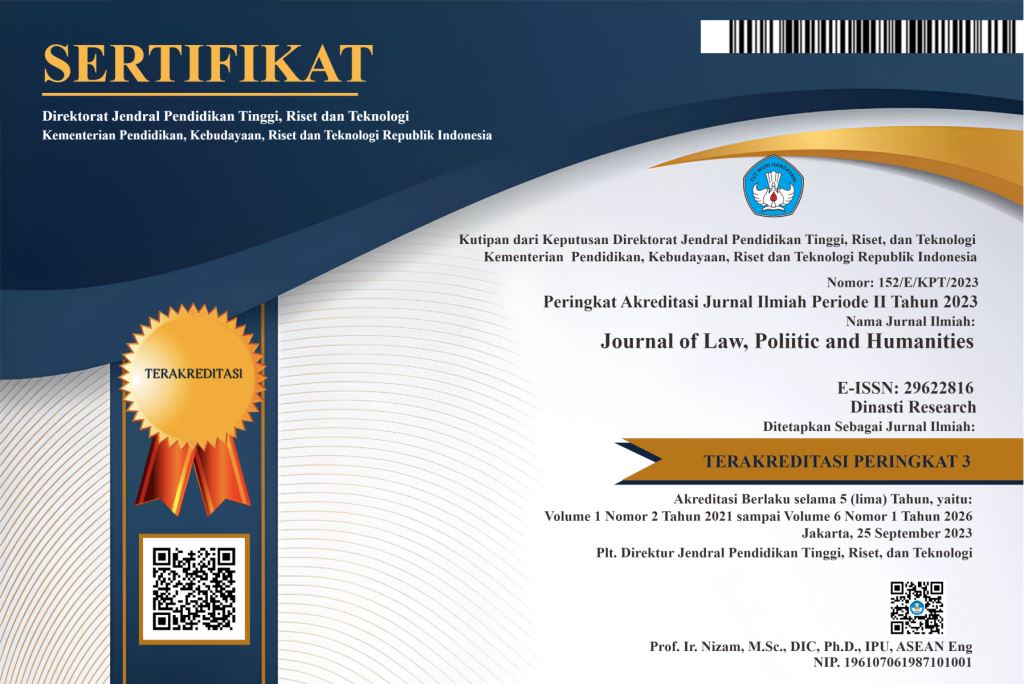Legality of the Use of Autonomous Weapons Systems in International Humanitarian Law
DOI:
https://doi.org/10.38035/jlph.v5i4.1575Keywords:
Autonomous Weapons Systems, War, International Humanitarian LawAbstract
Along with the development of the era, the world of weapons has increased until a system called Autonomous Weapons Systems was created which allows weapons to be able to determine and take action completely without human intervention. Autonomous Weapons Systems are feared to violate International Humanitarian Law. This study uses a normative legal research method that refers to positive law to be able to analyze a problem being studied, especially in the realm of international humanitarian law. This research was conducted with a literature study, where the author examines several legal materials such as primary, secondary, and tertiary legal materials used based on the problem. The results of the study indicate that the use of Autonomous Weapons Systems in armed conflict or war is something that is legally valid as long as it does not violate the international law that regulates it and must be in line with International Humanitarian Law. Countries and Individuals in the use of Autonomous Weapons Systems can be held accountable for Violations of International Humanitarian Law
References
Armin, Krishnan, Killer Robots Legality and Ethicality of Autonomous Weapons (Ashgatae
Publishing Company 2009).
International Committee of The Red Cross (ICRC) Casebook, “Martens Clause”, Online,
Internet,https://casebook.icrc.org/glossary/martens-clause .
Chandra, Umesh Jha, Killer Robots: Lethal Autonomous Weapon Systems Legal, Ethical, and
Moral Challenges (Vij Books India Pvt Ltd 2016).
DARPA, Generating Actionable Understanding of Real-World Phenomena with AI, January
, 2019, https://www.darpa.mil/news-events/2019- 01-04, accessed February
, 2025.
Davidson, Neil, 'A Legal Perspective: Autonomous Weapon Systems under International
Humanitarian Law' (2017) 30 UNODA Occasional Papers.
Declaration Recounting the Use, in Time of War, of Explosive Projectiles Under 400 Grammes Weight. Saint Petersburg, 29 November / 11 December 1868.
Draft articles on Responsibility of States for internationally wrongful acts adopted by the International Law Commission at its fifty-third session (2001) (extract from the Report of the International Law Commission on the work of its Fifty-third session, Official Records of the General Assembly, Fifty-sixth session, Supplement No. 10 (A/56/10), chp.IV.E.1).
Grumman, Northrop, Unmanned Combat Air System Carrier Demonstration at 2,
http://www.northropgrumman.com/Capabilit ies/X47BUCAS/Documents/X-
B_Navy_UCAS_FactSheet.pdf, accessed 12 February 2025.
Hosseini, Adja Ghasemi, Semi-Autonomous Weapon Systems in International Humanitarian Affairs Law - A study of the new decision-making and responsibility issue in International Humanitarian Law relating to Semi-Autonomous Weapon Systems (Lund University Thesis 2014).
Ibrahim, Ukas, 2018, “Legal Analysis of Disputes in Prospective Legal Studies
International”, Cahaya Keadilan Journal, Volume 6 Number 2. https:// ejournal.upbatam.ac.id/index.php/cahayakeadilan/article/view/1057 , accessed on February 11, 2025.
ICRC, Autonomous Weapon Systems: Technical, Military, Legal and Humanitarian Aspects
(Expert Meeting) (ICRC 2014).
International Committee of The Red Cross (ICRC), 2018, “Ethics and autonomous weapons systems: An ethical basis for human control?”.
International Committee of The Red Cross (ICRC), “A Guide to the Legal Review of New Weapons, Means and Methods of Warfare Measures to Implement Article 36 of Additional Protocol I of 1977”.
International Committee of The Red Cross (ICRC), “What is International Humanitarian Law?”, Online, Internet,https://www.icrc.org/en/doc/assets/files/other/what_is_ihl.pdf , accessed February 11, 2025.
Kereh, Joshua, "Legal Review of War Crimes in Armed Conflicts"
According to International Law", Lex Et Societatis, Vol. 7, No. 4, 2019, pp. 95-103. Kusumaatmadja, Mochtar, International Humanitarian Law in the Implementation and
Its application in Indonesia, Bina Cipta, Bandung, 1980. Article 86 paragraph (2) and Article 87 of Additional Protocol I 1977.
Petman, Jarna, Autonomous Weapons Systems and International Humanitarian Law: 'Out of
The Loop'? (Unigrafia Oy 2017).
Protocol additional to the Geneva Conventions of 12 August 1949, and relating to the
Protection of Victims of International Armed Conflicts (Protocol I), 8 June 1977.
Rome Statute of the International Criminal Court, 17 July 1998.
Schmitt, N. Michael, Autonomous Weapons Systems and International Humanitarian Law: A Reply to Critics, (Harvard National Security Journal, 2013).
SIPRI Insights on Peace and Security, 2015, “Implementing Article 36 Weapon Reviews in The Light of Increasing Autonomy in Weapon Systems”, No. 1 p.2, Online Internet, https://www.sipri.org/sites/default/files/files/insight/SIPRInsight1501.pdf , accessed on February 12, 2025.
Thomas, T. Bradan, Autonomous Weapon Systems: The Anatomy of Autonomy and The Legality of Lethality, via https://papers.ssrn.com/sol3/papers.cfm?abst ract_id=2503872.
Viotti and Kauppi in Irmawan Effendi, Cluster Bombs and Just War Theory: Protection
Civilians in War, ISIP Journal, Volume IX Number 1, January-June 2010.
Downloads
Published
How to Cite
Issue
Section
License
Copyright (c) 2025 Bobi Ardiansyah

This work is licensed under a Creative Commons Attribution 4.0 International License.
Authors who publish their manuscripts in this journal agree to the following conditions:
- The copyright on each article belongs to the author(s).
- The author acknowledges that the Journal of Law, Poliitic and Humanities (JLPH) has the right to be the first to publish with a Creative Commons Attribution 4.0 International license (Attribution 4.0 International (CC BY 4.0).
- Authors can submit articles separately, arrange for the non-exclusive distribution of manuscripts that have been published in this journal into other versions (e.g., sent to the author's institutional repository, publication into books, etc.), by acknowledging that the manuscript has been published for the first time in the Journal of Law, Poliitic and Humanities (JLPH).


























